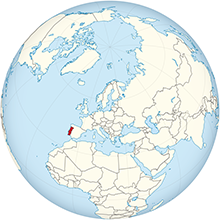Description of Figure/Doll
Figurine made completely from cork. A male doll is standing beside a tree, holding an ax, and cutting cork from a cork oak tree in Portugal. The man is wearing a dark vest and a tan had with a dark band. The top of the tree has silk fiber supporting the cork branches. Over fifty percent of the world's cork comes from the cork trees in Portugal. After the cork trees are about 25 years old, the cork tissue is debarked from the tree trunks and branches every nine years. Cork Oaks live for about 200 years, and the process does not injure the tree.Link to higher resolution images at ClipPix
Portugal
Location: Western Europe
Capital: Lisbon
Main language: Portuguese
Currency: Euro
Figure/Doll
Construction: cork from trees
Height in Centimeters: 15
Height in Inches: 6


Portugal: Land of Cork Oak Forests and White Marble Quarries
Reading Level: 4.45
My name is Pedro, and I’m 11 years old. I live near Estremoz, a small town in central Portugal. The nickname for Estremoz is “Ciudad Branca” or “White City” because there are many white buildings. Just outside town, are huge marble quarries. The big marble stones are mined in these quarries. Then, the white marble is used to construct buildings. We even have castles built with white marble in Estremoz. Our area is also known for cork oak forests. Cork (for wine bottles or bulletin boards) comes from the cork trees. It’s the only tree that can have its bark removed and still thrive. Cork bark can be removed every 9 years, and then it grows back. Since the trees can live up to 250 years, each tree can provide a lot of cork. Portugal produces about half of the cork in the whole world. My father works on a cork farm. Sometimes I can go along and help. For three months each year, they strip the bark from the cork trees. A team of strippers consists of 2 men. They use an axe, called a machado, which is razor sharp. First, they make a cut (being careful not to go too deep). Next, they peel the cork off the tree. Usually, a tree can be stripped in about 15 minutes. After the cork is removed from a tree, the date is painted on the tree trunk. The cork bark grows from the inside out, so the date remains visible for nine years. Then, the tree can be stripped again. I hope that someday, you will be able to visit Portugal. When you do, you’ll be able to drive past the cork forests and see the dates painted on the trunks. You’ll be surprised at how many people say, “I didn’t know cork grew on trees!”